NCERT Solutions for Class 10 Science Chapter 11 Human Eye and Colourful World
NCERT Solutions for Class 10 Science Chapter 11 Human Eye and Colourful World
NCERT Questions
In Text Book Questions
Question 1.
What is meant by power of accommodation of the eye ?
(CBSE Sample Paper 2010, 2012, 2014, 2015, 2016, 2017)
Answer:
The ability of the eye lens to adjust its focal length to see nearby and distant objects clearly.
Question 2.
A person with a myopic eye cannot see objects beyond 1.2 m distinctly. What should be the type of the corrective lens used to restore proper vision ?
Answer:

Question 3.
What is the far point and near point of the human eye with normal vision ? (CBSE 2011, 2012, 2014)
Answer:
The farthest position of an object from the human eye so that its sharp image is formed on the retina is at infinite distance from the eye.
The nearest position of an object from a human eye so that its sharp image is formed on the retina is at 25 cm from the eye.
Question 4.
A student has difficulty in reading the black board while sitting in the last row. What could be the defect the child is suffering from ? How can it be corrected ? (CBSE 2012)
Answer:
Near sightedness or myopia. This defect can be corrected by using a concave lens of suitable focal length.
NCERT Chapter End Exercises
Question 1.
Choose the correct option :
Human eye can focus objects at different distances by adjusting the focal length of the eye lens. This is due to
(a) presbyopia
(b) near sightedness
(c) accommodation
(d) far sightedness.
Answer:
(c).
Question 2.
Human eye forms the image of an object at its
(a) cornea
(b) iris
(c) pupil
(d) retina.
Answer:
(d).
Question 3.
The least distance of distinct vision for a young adult with normal vision is about (CBSE 2012, Bihar Board 2012)
(a) 25 m
(b) 2.5 cm
(c) 25 cm
(d) 50 cm. (CBSE 2011)
Answer:
(c).
Question 4.
The change in focal length of an eye lens is caused by the action of
(a) pupil
(b) retina
(c) ciliary muscles
(d) iris. (CBSE 2011)
Answer:
(c).
Question 5.
A person needs a lens of power – 5.5 diopters for correcting distant vision. For correcting his near vision, he needs a lens of power +1.5 diopter. What is the focal length of the lens required for correcting
(i) distant vision and
(ii) near vision ?
Answer:

Question 6.
The far point of a myopic person is 150 cm in front the eye. What is the nature and power of the lens required to correct the problem ?
Answer:

The lens is concave lens.
Question 7.
Make a diagram to show how hypermetropia is corrected. The near point of a hypermetropic eye is 1 m. What is the power of the lens required to correct this defect ? Assume that the near point of the normal eye is 25 cm.
(CBSE 2011)
Answer:
For diagram,
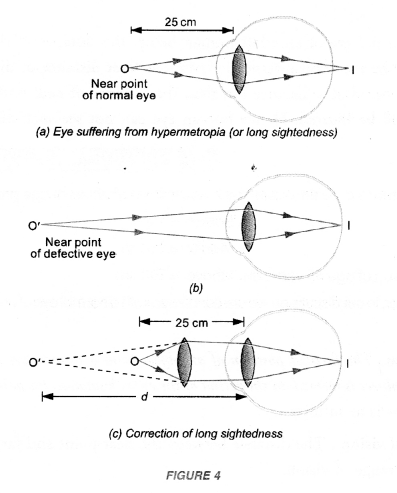

Question 8.
Why is a normal eye not able to see clearly the objects placed closer than 25 cm ? (CBSE 2011)
Answer:
The nearest position of an object from a normal human eye so that its sharp image is formed on retina is 25 cm. If the object is placed at a distance less than 25 cm, then the blurred image of the object is formed on retina as the focal length of eye lens cannot be decreased below a certain limit. Hence, eye cannot see it clearly.
Question 9.
What happens to the image distance in the eye when we increase the distance of an object from the eye ?
[CBSE (Delhi) 2008, 2011]
Answer:
The image distance remains the same in the eye because the eye has the ability to change the focal length of its lens to make the image always on the retina when the object distance increases from the eye.
Question 10.
Why do stars twinkle ? (CBSE 2011, 2012, 2015, 2016)
Or
Explain with the help of a labelled diagram, the cause of twinkling of stars. (CBSE 2014)
Answer:
Twinkling of Stars:
Light emitted by distant stars (act as point sources of light) passes through the atmosphere of the earth before reaching our eyes. The atmosphere of the earth is not uniform but consists of many layers of different densities. The layers close to the surface of the earth are optically denser. As we go higher and higher, the density of layers and refractive index decreases progressively. As the light from a star enters the uppermost layer of the atmosphere, it bends towards the normal as it enters the next layer. This process continues till the light enters our eyes. So due to refraction of light, the apparent position of the star is different from the actual position of the star (Figure 13).
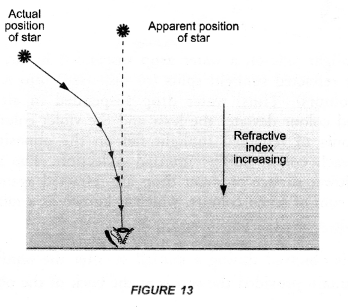
Question 11.
Explain why the planets do not twinkle. (CBSE 2011, 2012, 2015)
Answer:
Planets do not twinkle:
Planets are very close to the earth as compared to the stars. The planets act as extended sources of light. So the intensity of light we receive from the planets is very large. Therefore, the variation in the brightness of the planets is not detected. Hence, planets do not twinkle.
Question 12.
Why does the Sun appear reddish early in the morning ? (CBSE 2011, 2012)
Answer:
When sunlight enters the atmosphere of the earth, the atoms and molecules of different gases present in the atmosphere absorb this light. Then these atoms and molecules of the gases re-emit light in all directions. This process is known as scattering of light. The atoms or particles scattering light are known as scatters.
The intensity of scattered light is inversely proportional to the fourth power of the wavelength of incident light, if the size of the particles (say atoms or molecules) scattering the light is less than the wavelength of the incident light.
That is, intensity of scattered light, I ∝ 1/λ4.
We know, wavelength of red light is greater than the wavelength of blue or violet light. Therefore, the intensity of scattered red light is less than the intensity of the scattered blue or violet light.
The blue colour of sky, greenish blue colour of sea water, red colour of sunset and sunrise and white colour of clouds are due to the scattering of sun light by the particles present in the atmosphere of the earth.
Question 13.
Why does the sky appear dark instead of blue to an astronaut ?
[CBSE (Delhi) 2008, 2011, 2012, CBSE (Foreign) 2016]
Or
What will the colour of the sky be for an astronaut staying in international space station orbiting the earth 1 Justify your answer giving reason. (CBSE 2014)
Answer:
The blue colour of sky is due to the scattering of sunlight. The scattering of sunlight in the atmosphere is due to the presence of atoms and molecules of gases, droplets and dust particles. When the astronaut is in space, then there is no atmosphere (or atoms and molecules of gases, droplets and dust particles) around him. Therefore, sunlight does not scatter and hence sky appears dark.
Practical Skills Based Questions ( 2 Marks)
Question 1.
Draw a path of Light ray passing through a prism.
Label angle of incidence and angle of deviation in the ray diagram. (CBSE Sample Paper 2017-18)
Answer:
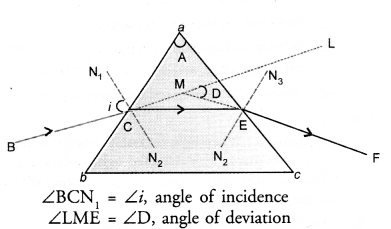
Question 2.
Draw the path of light ray passing through a glass prism. Label angle of incidence, angle of deviation and angle of emergence.
Answer:
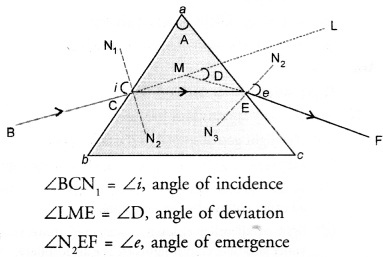
Question 3.
The path of a ray of light through a glass prism is shown below :
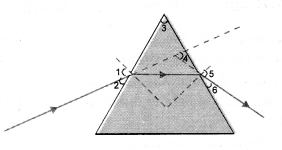
Write the names of the angles represented by 1, 3, 4 and 5 respectively.
Answer:
1. represents angle of incidence.
3. represents angle of prism.
4. represents angle of deviation
5. represents angle of emergence
Question 4.
The path of a ray of light through a glass prism is shown below :
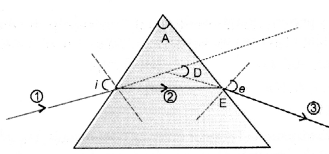
Name the incident ray of light, refracted ray of light and emergent ray of light.
Answer:
- represents incident ray of light
- represents refracted ray of light
- represents emergent ray of light
Question 5.
The path of a ray of light passing through a glass prism is shown below :
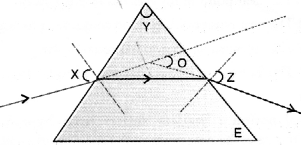
Name the angles X, Y, Z and O
Answer:
∠X = Incident angle
∠Y = Angle of prism
∠Z = Angle of emergence
∠O = Angle of deviation
Question 6.
A beam of white light falling on a glass prism gets split up into seven colours marked 1 to 7 on a screen as shown in figure.
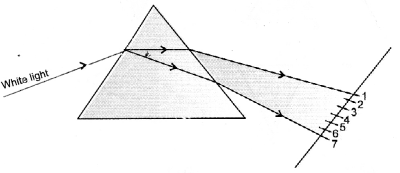
Name the colours similar to the colour of
- danger or stop signal light
- core of hard boiled egg
- colour of clear sky
- solution of potassium permanganate
Answer:
- 1 is red colour which corresponds to the colour of danger or stop signal light.
- 3 is yellow colour which corresponds to the colour of hard boiled egg.
- 5 is blue colour which corresponds to the colour of clear sky.
- 7 is violet colour which corresponds to the colour of the solution of potassium permanganate.
HOTS Questions for Class 10 Science Chapter 11 Human Eye and Colourful World
Question 1.
A person is able to see objects clearly only when these are lying at distance between 50 cm and 300 cm from his eye.
- What kind of defect of vision he is suffering from ?
- What kind of lenses will he required to increase his range of vision from 25 cm to infinity ? Explain briefly.
Answer:
- For a normal eye, the near point is at 25 cm and the far point is at infinity from the eye. The given
person cannot see object clearly either closer to the eye or far away from the eye. So, he is suffering horn both myopia and hypermetropia. - A bi-focal lens consisting of a concave lens and convex lens of suitable focal lengths will be required to correct the defects and to increase his range or vision from 25 cm to infinity. In a bi-focal lens, upper portion is concave which corrects distant vision and lower portion is convex which corrects near vision.
Question 2.
A student finds the writing on the black board as blurred and unclear when sitting on the last desk in a classroom. He however, sees it clearly when sitting on the front desk at an approximate distance of 2 m from the black board.
(a) Draw ray diagrams to illustrate the formation of image of the black board writing by his eye-lens when he is seated at the
- last desk,
- front desk. (CBSE 2011, 2015)
(b) Name the kind of lens that would help him to see clearly even when he is seated at the last desk. Draw a ray diagram to illustrate how this lens helps him to see clearly. (CBSE 2011, 2012, 2015)
Answer:
(a)
- Formation of image of the black board writing by the eye-lens of the student sitting at the last desk is shown in figure.

- Formation of image of the black board writing by the eye-lens of the student sitting at the front-desk is shown in figure.

(b) Student is suffering from Myopia, so his eye defect can be corrected by using a concave lens as shown in figure.

Question 3.
A student finds the writing on the black board as blurred and unclear while sitting on the front desk in a classroom of a big size. He however, sees it clearly while sitting on the last desk of the classroom.
(a) Draw ray diagrams to illustrate the formation of image of the black board writing by his eye-lens when he is seated at
- the front desk,
- last desk.
(b) Name the defect, the eye of the student is suffering from?
(c) Name the type of lens that would enable him to see the black board writing clearly, when seated on the front desk.
(d) Draw a ray diagram to illustrate how this lens helps him to see clearly.
Answer:
(a)
- Formation of image of black board writing by the eye-lens of the student sitting on the front desk is shown in figure.
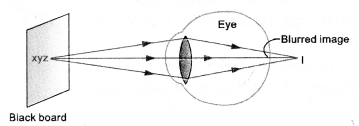
- Formation of the image of the black board writing by the eye-lens of the student sitting on the last desk is shown in figure.
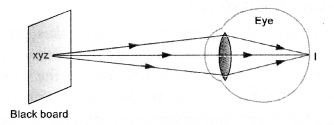
(b) Student’s eye suffers from hypermetropia or long sightedness as he is able to see far off object clearly but unable to see near object clearly.
(c) Convex lens of suitable focal length.
(d)
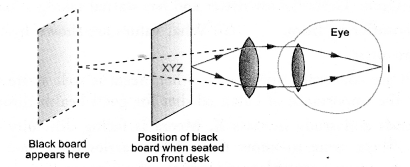
Question 4.
A person cannot see object farther than 10m from the eye clearly. Name the defect of vision, he is suffering from. How can it be corrected ? Draw ray diagrams for
- defective eye,
- its correction.
Answer:
He is suffering from myopia or short-sightedness. The defect can be corrected using spectacles having concave lens.
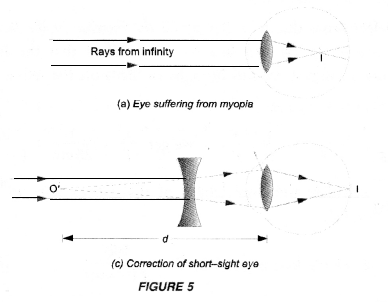
Question 5.
A 14-years old student is not able to see clearly the questions written on a black board placed at a distance of 5 m from him.
(a) Name the defect of vision, he is suffering from.
(b) With the help of labelled ray diagram show how this defect can be corrected.
(c) Name the type of lens used to correct this defect.
(d) State two causes of this defect. (CBSE 2007, 2011, 2013, 2017)
Answer:
(a) Student is suffering from Myopia or short-sightedness
(b) For ray diagram,

(c) Concave lens of suitable focal length is used to correct this defect.
(d) It is due to
- elongation of the eye ball,
- excessive curvature of the cornea.
Question 6.
A beam of white light falling on a glass prism gets split up into seven colours marked 1 to 7 as shown in the diagram. A student makes the following statements about the spectrum observed on the screen.
(a) The colours at position marked 3 and 5 are similar to the colour of the sky and the core of a hard boiled egg respectively. Is the statement made by the student correct or incorrect ? Justify.
(b) Which two positions correspond closely to the colour of
- a solution of potassium permanganate ?
- Danger or stop signal lights ? (CBSE 2011, 2012, 2016)
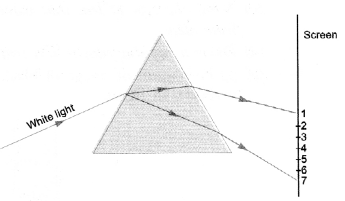
Answer:
(a) (i) The colours at positions 3 and 5 are yellow and blue respectively. On the other hand, student has identified them as blue (i.e colour of sky) and yellow (colour of the core of a hard boiled egg) respectively. Hence, the statement is incorrect.
(b)
- Position 7 is the position of violet colour, which corresponds to the colour of a solution of potassium permanganate.
- Position 1 is the position of red colour, which corresponds to the colour of ‘danger’ or stop signal lights.
Question 7.
A glass prims is able to produce a spectrum when white light passes through it but a glass slab does not produce any spectrum. Explain. Why is it so ? [CBSE (All India) 2009]
Answer:
When white light enters the glass slab, dispersion of light takes place. The angle of refraction for violet colour is more than for red colour on entering the glass slab. But all colours of light return to the original direction of propagation while refracting from other side of the glass slab and thus white light emerges out of the glass slab. Hence, glass slab does not produce any spectrum.
Value Based Questions in Science for Class 10 Chapter 11 Human Eye and Colourful World
Question 1.
Seeta and Geeta are best friends and study in class X. Geeta is facing difficulty in reading the black board text from he bench in the first row in a classroom. Seeta wonders why Geeta avoids sitting in the first row. Seeta came to know that Geeta avoids milk and green vegetables. She started sharing her lunch-full of green vegetables and fruits with Geeta. Geeta is now better and has started taking a ’balanced diet’.
- Name the eye defect Geeta is suffering from.
- What values are shown by Seeta and Geeta ?
Answer:
- Hypermetropia or long sightedness.
- Both are good friends. Both are concerned about each other. Seeta is well aware of the importance of balanced diet. Geeta also learnt the importance of balanced diet for good health through Seeta.
Question 2.
Maya and Meera are good friends and study in class X. Meera is facing difficulty in reading the black board text from the last desk. Maya came to know that Meera carries junk food in her lunch. Maya started sharing her lunch full of green vegetables and fruits. She alsô motivated Meera to consult a doctor and for the check up of her eyes. Meera is now better and started taking a ’balanced diet’.
- Name the eye defect Meera is suffering from.
- What value is shown by Maya and Meera ?
Answer:
- Myopia or short sightedness.
- Concern for each other, friendship and importance of balanced diet.
Question 3.
Arun is a student of class X. One day, when he was coming from his school, he saw that an old man was finding it difficult to cross a busy road. An old man was unable to see the nearer objects. Arun helped the old man to cross the road.
- Name the defect of vision an old man was suffering,
- Name the lens used to correct this defect of vision.
- What values are shown by Arun ?
Answer:
- Hypermetropia or long – sightedness.
- Convex lens.
- Arun is helpful. He is concerned about others. He thinks that it was his moral duty to help old and needy persons.
NCERT Exemplar Solutions for Class 10 Science Chapter 11 Human Eye and Colourful World
Question 1.
A person cannot see distinctly objects kept beyond 2 m. This defect can be corrected by using a lens of power
(a) +0.5 D
(b) -0.5 D
(c) +0.2 D
(d) -0.2 D
Answer:
(b).
Explanation : Person is suffering from myopia. Focal length of the lens used to correct the defect, f = – d = – 2 m

Question 2.
A student sitting on the last bench can read the letters written on the black board but is not able to read the letters written in his test book. Which of the following statements is correct ?
(a) The near point of his eyes has receded away
(b) The near point of his eyes has come closer to him
(c) The far point of his eyes has receded away
(d) The far point of his eyes has come closer to him.
Answer:
(a).
Explanation : Student suffers from hypermetropia. In this case, the near point of the eye recedes away.
Question 3.
A student wants to have third colour from the top corresponds to the colour of the sky after the dispersion of white light through a glass prism. He placed prism ABC with BC as base as shown in figures P, Q, R and S. Which position of the prism is correct ?
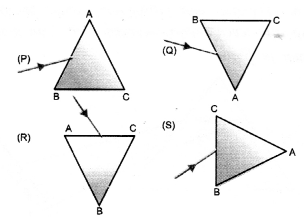
(a) P
(b) Q
(c) R
(d) S.
Answer:
(b).
Explanation : Colour of sky is blue.
Question 4.
At noon, the sun appears white as
(a) light is least scattered
(b) all the colours of the white light are scattered away.
(c) blue colour is scattered the most
(d) red colour is scattered the most
Answer:
(a).
Explanation : At noon, scattering of all colours is almost same.
Question 5.
Which of the following phenomena of light are involved in the formation of a rainbow ?
(a) Reflection, refraction and dispersion
(b) Refraction, dispersion and total internal reflection.
(c) Refraction, dispersion and internal reflection.
(d) Dispersion, scattering and total internal reflection
Answer:
(c).
Explanation : When light falls on a droplet, refraction of light takes place. This refracted light suffers dispersion. Then the light suffer total internal reflection from other surface of the droplet.
Question 6.
Twinkling of stars is due to atmospheric
(a) dispersion of light by water droplets
(b) refraction of light by different layers of varying refractive indices.
(c) scattering of light by dust particles
(d) internal reflection of light by clouds.
Answer:
(b).
Explanation : When sun light enters the earth’s atmosphere, it continuously goes from rarer to the denser medium and hence refraction of light takes place. The refraction of light taking place in the atmosphere is known as atmospheric refraction.
Question 7.
The clear sky appears blue because
(a) blue light gets absorbed in the atmosphere
(b) ultraviolet radiations are absorbed in the atmosphere.
(c) violet and blue lights get scattered more than lights of all other colours by the atmosphere.
(d) light of all other colours is scattered more than the violet and blue colour lights by the atmosphere.
Answer:
(c).
Explanation : Intensity of scattered light, I ∝ 1/λ4 . The wavelength of blue and violet light is smaller than the wavelengths of other colours.
Question 8.
Which of the following statements is correct regarding the propagation of light of different colours of white light in air ?
(a) Red light travels fastest.
(b) Blue light moves faster than green light.
(c) All the colours of white light move with the same speed.
(d) Yellow light moves with the mean speed as that of the red and the violet light.
Answer:
(c).
Explanation : There is no dispersion of white light in air. So all colours travel with the same speed.
Question 9.
The clanger signals installed at the top of tall building are red in colour. These can be seen from a distance because among all other colours, the red light
(a) is scattered the most by smoke or fog
(b) is scattered the least by smoke or fog
(c) is absorbed the most by smoke or fog
(d) moves fastest in air
Answer:
(b).
Explanation : Intensity of scattered light, I ∝ 1/λ4 . Since the wavelengths of red light is greater than the wavelengths of all other lights, therefore, red colour can be seen from a distance.
Question 10.
Which of the following phenomena contributes significantly to the reddish appearance of the sun at sunrise or sunset ?
(a) Dispersion of light
(b) Scattering of light
(c) Total internal reflection of light
(d) Reflection of light from the earth.
Answer:
(b).
Explanation : Intensity of scattered light, I ∝ 1/λ4. Since the wavelength of red light is greater than the wavelengths of all other lights, therefore, red colour is scattered least and confined around the sun.
Question 11.
Water in deep sea is bluish in colour due to
(a) absorption of light by the sea
(b) reflection of sky in water
(c) scattering of light
(d) presence of plants in the sea.
Answer:
(c).
Question 12.
When light rays enter the eye, most of the refraction occurs at the
(a) crystalline lens
(b) outer surface of the cornea
(c) iris
(d) pupil
Answer:
(b).
Question 13.
The focal length of the eye lens increases when eye muscles
(a) are relaxed and lens becomes thinner
(b) contracts and lens becomes thicker
(c) are relaxed and lens becomes thicker
(d) contract and lens becomes thinner
Answer:
(a).
Explanation : Focal length of thin lens is greater than the focal length of thick glass.
Question 14.
Which of the following statement is correct ?
(a) A person with myopia can see distant objects clearly.
(b) A person with hypermetropia can see nearby objects clearly.
(c) A person with myopia can see nearly objects clearly.
(d) A person with hypermetropia cannot see distant objects clearly.
Answer:
(c).
Explanation : Hypermetropia : A person suffering from this defect can see far off objects clearly but cannot see nearby objects clearly.
Myopia : A person suffering from this defect can see nearby objects clearly but cannot see far off objects clearly.
Question 15.
Draw ray diagrams each showing
(i) myopic eye and
(ii) hypermetropic eye.
Answer:
(i)

(ii)
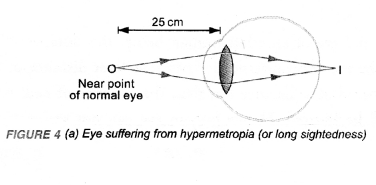
Question 16.
A student sitting at the back of the classroom cannot read clearly the letters written on the black board. What advice will a doctor give to her ? Draw ray diagram for the correction of this defect.
Answer:
Doctor will advice the student to wear spectacles havi ng con¬cave lens of suitable focal length or power as she is suffering from myopia.
For diagram,
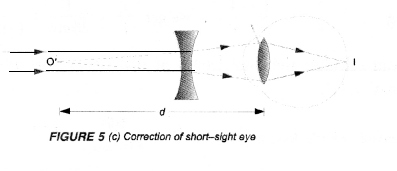
Question 17.
How are we able to see nearby and also the distant objects clearly? (CBSE 2012)
Answer:
Human eye is able to see nearby and also the distant objects clearly using its power of accommodation.
Question 18.
A person needs a lens of power -4.5 D for correction of her vision.
(a) What kind of defect is she suffering from ?
(b) What is the focal length of the corrective lens ?
(c) What is the nature of the corrective lens ?
(CBSE Sample Paper 2017-18)
Answer:
(a) She is suffering from myopia
![]()
(c) Concave lens.
Question 19.
How will you use two identical prisms so that a narrow beam of white light incident on one prism emerges out of the sec¬ond prism as white light ? Draw the diagram.
Answer:
Perform an activity to show that the colours of white light splitted by a glass prism can be recombined to get white light by another glass prism.
Apparatus required. Two glass prisms made of same kind of glass, a card board having a fine hole at its centre, a white screen.
Procedure:
- Place a card board in front of a prism A. A ray of white light coming from the hole in the card board falls on the prism A (Figure 11).
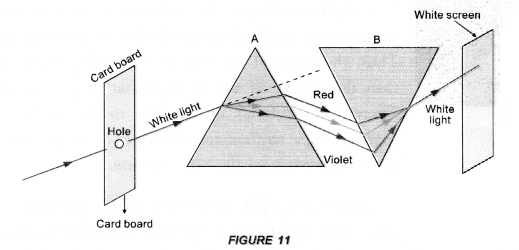
- White light splits into seven colours by prism A is made to fall on another glass prism B placed with its base upward. Since prism A disperses white light, so it is known as dispersing prism.
- The prism B deviates colours of light towards its base. The various colours recombines at the opposite lace of glass prism B.
- This activity was initially performed by the great scientist Issac Newton.
The light received on the white screen placed in front of prism B is white. Since the prism B recombines the colours of light to produce white light, so glass prism B is known as recombination prism.
Question 20.
Draw a ray diagram showing the dispersion through a prism when a narrow beam of white light is incident on one of its refracting surfaces. Also indicate the order of the colours of the spectrum obtained.
Answer:
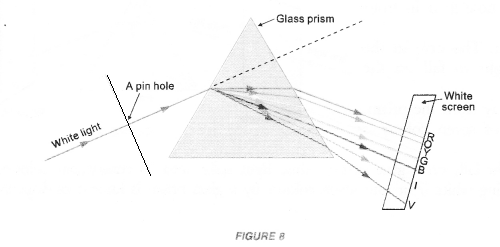
Question 21.
Is the position of a star as seen by us its true position. Justify your answer.
Answer:
No.
Light emitted by distant stars (act as point sources of light) passes through the atmosphere of the earth before reaching our eyes. The atmosphere of the earth is not uniform but consists of many layers of different densities. The layers close to the surface of the earth are optically denser. As we go higher and higher, the density of layers and refractive index decreases progressively. As the light from a star enters the uppermost layer of the atmosphere, it bends towards the normal as it enters the next layer. This process continues till the light enters our eyes. So due to refraction of light, the apparent position of the star is different from the actual position of the star (Figure 13).
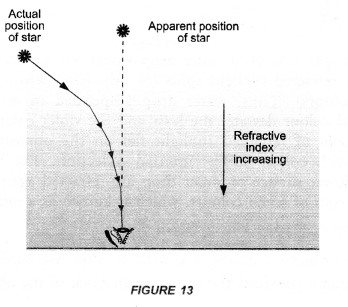
Question 22.
Why do we see a rainbow in the sky only after rainfall ?
Answer:
Rainbow is the example of dispersion of sunlight. In sky, prism like objects are needed for the dispersion of light. After rainfall, tiny water drops suspended in air act as prisms. Hence, we see a rainbow in the sky only after rainfall.
Question 23.
Why is the colour of clear sky blue ?
Answer:
When sunlight enters the earth’s atmosphere, the atoms or molecules of the gases present in the atmosphere scatter this light. Since wavelength of red colour is larger than the wavelengths of other colours in sunlight, so red colour is scattered least. Violet colour is scattered the most followed by blue, green, yellow, orange and red colours respectively. Our eye is more sensitive to the blue light than the violet light. Therefore, scattered light in the sky contains blue colour in plenty and hence the clear sky appears blue.
Note : Sky appears greyish over cities having industrial units. The smoke and dust particles in the atmosphere over such cities scatter red, orange and yellow colours more than other colours of small wavelengths. Hence, the sky appears greyish.
Question 24.
What is the difference in colours of the sun observed during sunrise/sunset and noon ? Give explanation for each.
Answer:
At the time of sunrise or sunset, the position of the sun is very far away from us (Figure 16).
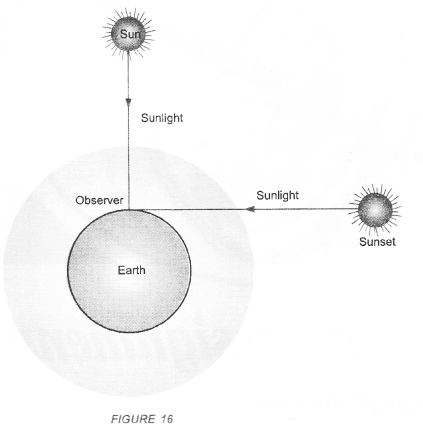
The sunlight travels longer distance through the atmosphere of the earth before reaching our eyes. Scattering of blue light is more than the scattering of red light. As a result of this, more red light reaches our eyes than any other colour. Hence sunset and sunrise appear red.
During noon, the sun is overhead and sunlight travels less distance through the earth’s atmosphere to reach our eyes. In this case, the scattering of almost all colours is very small. Hence, the sun appears white.
